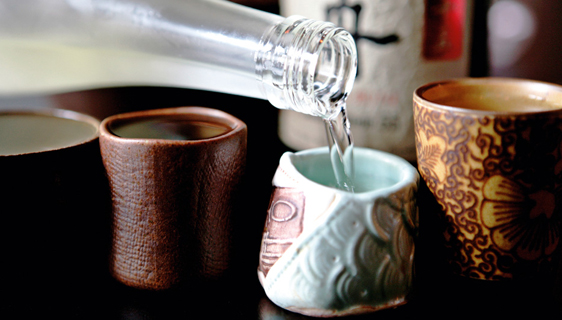Sake is an alcoholic beverage made from fermented rice. Sometimes referred to as rice wine, sake is produced by a similar brewing process to that of beer’s.
Sake may sound like a simple product, rice, water and yeast, however the slightest change to the process can make a world of difference. The source of the rice is crucial to the consistency of the product. And variation in the koji production, or the temperature of the fermentation can also result in a drastically different profile. The process of making this delectable beverage is truly an art that has evolved over the centuries until today.
 The alcoholic content of sake is higher than beer, generally between 12% and 18% alcohol by volume, and has a complex, even fruity flavor when made by a high quality manufacturer.
The alcoholic content of sake is higher than beer, generally between 12% and 18% alcohol by volume, and has a complex, even fruity flavor when made by a high quality manufacturer.
Sake Classification
The process and classification Sake depends on how much the rice has been milled, polished, and filtered. Rice used in the production is polished, or ‘milled,’ removing much of the outer coating. As much as 65% of the grain is milled away in some premium Sake, leaving only a small amount of the grain to be used in production. The degree of milling will greatly influence the quality of the final product, and there are five designations for sake, depending on the degree of milling and additives in the final product.
Junmai-shu: ‘Pure’ sake with no distilled alcohol added as a finishing ingredient. Traditionally, 30% of the grain had to be milled away for this designation, however recently there are no longer any milling requirements by law, except that no alcohol may be added to the product.
Honjozo-shu: at least 30% of the grain milled away and a modicum of alcohol has been added during finishing.
Ginjo-shu: about 40% of the grain milled away and may or may not have alcohol added during the finishing. If bottle is labeled Ginjo, it indicates that distilled alcohol was added and if it is labeled Junmai Ginjo, it means there was no alcohol added.
Daiginjo-shu: about 50% of the grain milled away and also may or may not have had alcohol added during finishing. If bottle is labeled Daiginjo, it indicates that distilled alcohol was added and if it is labeled Junmai Daiginjo, it means there was no alcohol added.
Namazake: This means that the sake was not pasteurized before bottling. Sake is generally pasteurized to kill any bacteria or mold that may contaminate or ruin the final product in some way. It also serves to deactivate certain enzymes that may change the characteristics of the Sake before it reaches the consumer.

Benefits of Sake
Sake contains the most amino acids of all alcoholic beverages. In fact, there are 7 times more amino acids in saké than in red wine. Amino acids play a role in preventing cancer, shrinking cancer cells, and, in some cases, killing cancer cells. It is low in acidity compared to wine, easy on the throat and stomach. Sake isn’t just a delicious beverage – it’s a nutritious treat for your skin. Kojic acid is produced in sake as a part of the fermentation process. When applied topically to the skin, kojic acid has the ability to fade spots of dark pigmentation by inhibiting tyrosinase, an enzyme in the skin that stimulates melanin production and causes dark spots to form over time.
Warm Vs Chilled Sake
A general rule is that all types of sake can be enjoyed chilled, but Ginjo and DaiGinjo-type sakes should not be warmed. Below are guidelines for the two fundamental categories of sake:
- Junmai-type and Tokubetsu-Junmai sakes: Serve at room temperature to warm
- Ginjo-type and DaiGinjo type sakes: Serve chilled to room temperature
Sake’s delicate bouquet, aroma and soft body are easily affected by serving temperatures. Hence, when warming or chilling sake, do not over heat or over chill.
Pairing Sake with Food
In general, pairing of sake with foods can be considered by the characteristics of the two fundamental sake types:
Junmai -type sake: With its full and complex flavors, enhanced by warming, Junmai-type sake is ideal with a wide variety of food, from delicate sushi to rich meat dishes. Serve slightly chilled to room temperature.
Ginjo type sake: Ginjo sake, produced with highly polished rice, has a clean and delicate flavor with a lingering sweetness. Enjoyed as a dessert wine, it is excellent with light appetizers. Avoid pairing with dishes prepared with soy sauce or miso, as the rich taste of these products will interfere with the delicate Ginjo taste.
Moderate intake of Japanese Sake bring various benefits to your health. Start now to experience it with our collection of Sake for your pickings: https://www.oaks.com.sg/c/1273/Sake

